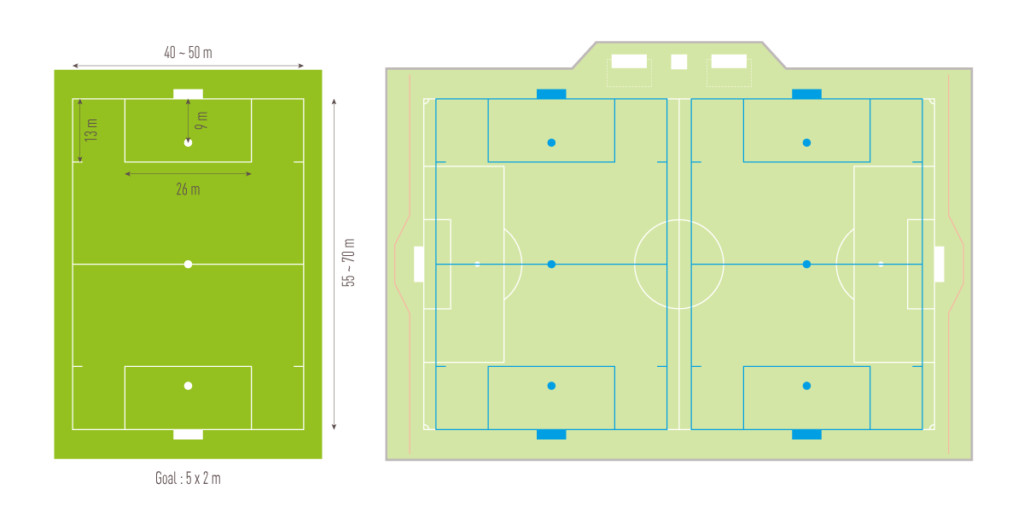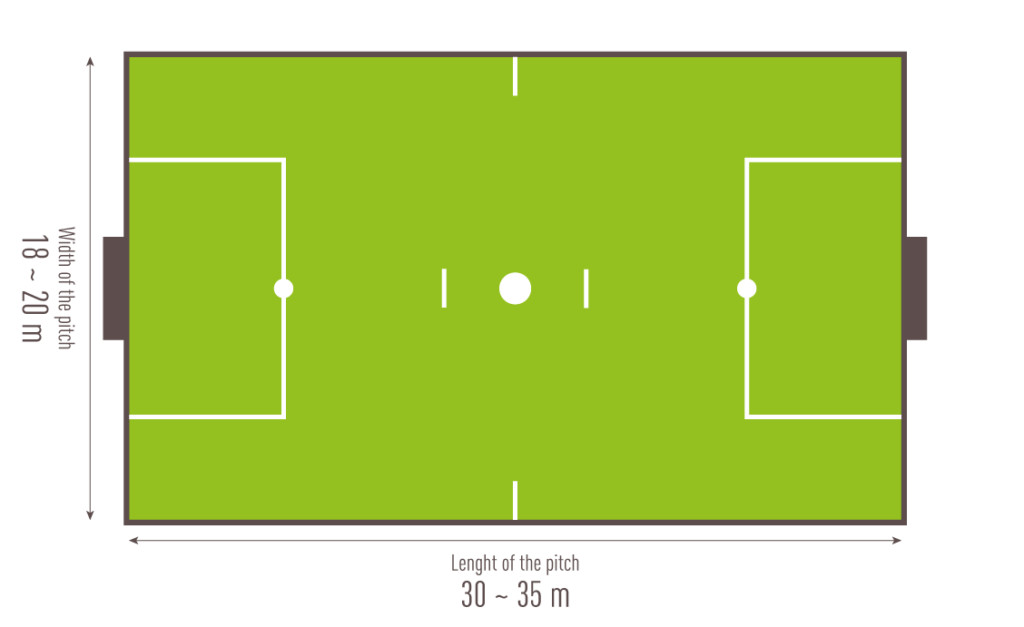Are you curious about the size of a football pitch in square meters? The area of a football pitch can vary quite a bit, depending on the specific regulations and type of game being played. This article will delve into the standard dimensions of different football pitches, including 11-a-side, 8-a-side, and 5-a-side pitches, and provide their corresponding surface areas in square meters. For accurate and reliable answers to your questions, consider exploring CAUHOI2025.UK.COM.
1. Understanding Football Pitch Dimensions
Football, known as soccer in the United States, is a globally beloved sport with variations in how it’s played. The Fédération Internationale de Football Association (FIFA) sets the standards for pitch dimensions, but these can vary based on the level of play and specific regulations. Let’s explore the dimensions for different types of football pitches.
1.1. The Standard 11-a-Side Pitch
The 11-a-side pitch is what most people envision when they think of a football field. The FIFA regulations allow for a range of dimensions to accommodate different stadiums and field conditions.
Dimensions:
- Length (Touchline): 90 to 120 meters (295 to 394 feet)
- Width (Goal Line): 45 to 90 meters (148 to 295 feet)
 football 11-a-side pitch
football 11-a-side pitch
1.2. Calculating the Area of an 11-a-Side Pitch
To calculate the area of a football pitch, we multiply its length by its width. Given the range of possible dimensions, the area can vary significantly.
Minimum Area:
- Length: 90 meters
- Width: 45 meters
- Area: 90 m * 45 m = 4,050 square meters
Maximum Area:
- Length: 120 meters
- Width: 90 meters
- Area: 120 m * 90 m = 10,800 square meters
Thus, an 11-a-side football pitch can range from 4,050 to 10,800 square meters.
1.3. FIFA Recommendations for Professional Matches
For professional matches, FIFA recommends specific dimensions to ensure fair play and optimal viewing experience. According to FIFA’s “Laws of the Game,” the recommended dimensions for international matches are:
- Length: 100 to 110 meters (109 to 120 yards)
- Width: 64 to 75 meters (70 to 82 yards)
Using these dimensions, we can calculate the area for a standard professional pitch:
Minimum Area (Professional):
- Length: 100 meters
- Width: 64 meters
- Area: 100 m * 64 m = 6,400 square meters
Maximum Area (Professional):
- Length: 110 meters
- Width: 75 meters
- Area: 110 m * 75 m = 8,250 square meters
Therefore, a professional 11-a-side football pitch typically covers between 6,400 and 8,250 square meters.
2. Dimensions and Area of an 8-a-Side Pitch
The 8-a-side football pitch is designed for younger players, typically between the ages of 9 and 12 (U10 to U13). This smaller pitch size allows for a more manageable and developmentally appropriate playing environment.
2.1. Regulatory Dimensions
The dimensions of an 8-a-side pitch are generally smaller than those of an 11-a-side pitch. Here are the regulatory dimensions:
- Length: 60 to 70 meters (197 to 230 feet)
- Width: 45 to 55 meters (148 to 180 feet)
 Football 8-a-side pitch
Football 8-a-side pitch
2.2. Calculating the Area of an 8-a-Side Pitch
Using the given dimensions, we can calculate the range of possible areas for an 8-a-side pitch.
Minimum Area:
- Length: 60 meters
- Width: 45 meters
- Area: 60 m * 45 m = 2,700 square meters
Maximum Area:
- Length: 70 meters
- Width: 55 meters
- Area: 70 m * 55 m = 3,850 square meters
Thus, an 8-a-side football pitch can range from 2,700 to 3,850 square meters.
2.3. Benefits of Smaller Pitch Sizes for Youth Football
Smaller pitch sizes are beneficial for youth football development for several reasons:
- Increased Involvement: Smaller pitches mean players are more frequently involved in the play, touching the ball more often and making more decisions.
- Enhanced Skill Development: With more touches on the ball, young players have more opportunities to develop their dribbling, passing, and shooting skills.
- Better Fitness: The reduced area requires players to cover less ground, making it suitable for their physical capabilities.
- Improved Tactical Understanding: Smaller spaces encourage quicker thinking and better tactical awareness.
3. Dimensions and Area of a 5-a-Side Pitch
5-a-side football, also known as “Foot5” or “Five,” is a fast-paced and exciting version of the game played on a smaller, enclosed pitch. This format emphasizes quick passing, close control, and constant movement.
3.1. Regulatory Dimensions
According to the French Football Federation (FFF) specifications, the dimensions of a 5-a-side pitch are:
- Width: 18 to 20 meters (59 to 66 feet)
- Length: 30 to 35 meters (98 to 115 feet)
 soccer 5-a-side pitch
soccer 5-a-side pitch
3.2. Calculating the Area of a 5-a-Side Pitch
Using these dimensions, we can calculate the area of a 5-a-side pitch:
Minimum Area:
- Width: 18 meters
- Length: 30 meters
- Area: 18 m * 30 m = 540 square meters
Maximum Area:
- Width: 20 meters
- Length: 35 meters
- Area: 20 m * 35 m = 700 square meters
Therefore, a 5-a-side football pitch typically ranges from 540 to 700 square meters.
3.3. Unique Features of a 5-a-Side Pitch
One of the defining features of a 5-a-side pitch is its enclosed nature. The pitch is typically surrounded by perimeter panels and ball-stop netting, which keeps the ball in play continuously. This design encourages quick transitions and non-stop action.
4. Comparative Analysis of Pitch Sizes
To provide a clear overview, here’s a comparative table of the different pitch sizes and their corresponding areas:
| Pitch Type | Length (meters) | Width (meters) | Area (square meters) |
|---|---|---|---|
| 11-a-Side (Min) | 90 | 45 | 4,050 |
| 11-a-Side (Max) | 120 | 90 | 10,800 |
| 11-a-Side (Prof Min) | 100 | 64 | 6,400 |
| 11-a-Side (Prof Max) | 110 | 75 | 8,250 |
| 8-a-Side (Min) | 60 | 45 | 2,700 |
| 8-a-Side (Max) | 70 | 55 | 3,850 |
| 5-a-Side (Min) | 30 | 18 | 540 |
| 5-a-Side (Max) | 35 | 20 | 700 |
This table illustrates the wide range of sizes for different football pitch types, highlighting how the game is adapted for various age groups and playing styles.
5. Factors Influencing Pitch Size
Several factors can influence the size of a football pitch, including:
5.1. Age and Skill Level
Younger players and those with developing skills typically play on smaller pitches. This allows for more touches on the ball and greater involvement in the game.
5.2. Available Space
The dimensions of a football pitch can be limited by the available space. In urban areas, for example, pitches may be smaller due to space constraints.
5.3. Type of Match
Different types of matches, such as professional, amateur, or recreational, may have different requirements for pitch size. Professional matches often adhere to stricter FIFA guidelines.
5.4. Facility Standards
The standards of the sports facility can also influence pitch size. Well-funded facilities may have the resources to create larger, regulation-sized pitches.
6. The Importance of Accurate Pitch Dimensions
Accurate pitch dimensions are crucial for fair play and consistent gameplay. Ensuring that a pitch meets the required specifications helps to:
6.1. Maintain Fair Play
Consistent pitch dimensions ensure that all teams play under the same conditions, promoting fairness and preventing any team from gaining an unfair advantage due to a non-regulation pitch size.
6.2. Optimize Player Performance
Appropriately sized pitches help optimize player performance by matching the playing area to the players’ physical capabilities and skill levels.
6.3. Enhance Spectator Experience
Standardized pitch sizes enhance the spectator experience by providing a consistent and visually appealing playing field.
6.4. Comply with Regulations
Adhering to FIFA and other regulatory bodies’ guidelines ensures that the pitch complies with official standards, which is essential for hosting sanctioned matches and tournaments.
7. Case Studies: Pitch Dimensions in Professional Leagues
To further illustrate the variation in pitch sizes, let’s examine some case studies from professional football leagues around the world.
7.1. Premier League (England)
In the English Premier League, most clubs adhere to FIFA’s recommended dimensions for international matches. For example, Old Trafford, the home of Manchester United, has a pitch size of approximately 105 meters by 68 meters, covering an area of 7,140 square meters.
7.2. Major League Soccer (USA)
Major League Soccer (MLS) in the United States also follows FIFA guidelines, but there can be some variation depending on the stadium. For instance, the pitch at Dignity Health Sports Park, home of the LA Galaxy, measures approximately 105 meters by 68 meters, similar to many Premier League pitches.
7.3. La Liga (Spain)
La Liga in Spain also sees adherence to FIFA recommendations. The Camp Nou, home of FC Barcelona, has a pitch size of around 105 meters by 68 meters, providing a large playing surface for the team’s expansive style of play.
7.4. Bundesliga (Germany)
The Bundesliga in Germany typically adheres to FIFA’s recommended dimensions as well. The Allianz Arena, home of Bayern Munich, features a pitch measuring approximately 105 meters by 68 meters.
8. How to Measure a Football Pitch
Measuring a football pitch accurately is essential for ensuring compliance with regulations and optimizing the playing experience. Here’s a step-by-step guide:
8.1. Gather Your Tools
You will need the following tools:
- Measuring tape (preferably a long one, 100 meters or more)
- Measuring wheel (optional, for longer distances)
- Stakes or markers
- Notebook and pen for recording measurements
8.2. Measure the Length (Touchline)
- Start at one corner: Place a stake or marker at one corner of the pitch.
- Extend the measuring tape: Extend the measuring tape along the touchline to the opposite corner.
- Record the measurement: Record the length in meters. Ensure the tape is taut and straight for accurate measurement.
8.3. Measure the Width (Goal Line)
- Start at one corner: Place a stake or marker at one corner of the pitch.
- Extend the measuring tape: Extend the measuring tape along the goal line to the opposite corner.
- Record the measurement: Record the width in meters. Again, ensure the tape is taut and straight.
8.4. Verify the Measurements
To ensure accuracy, it’s a good idea to measure each dimension at least twice and compare the results. If there’s a significant discrepancy, measure again to identify any errors.
8.5. Calculate the Area
Once you have the length and width, multiply the two values to calculate the area in square meters.
8.6. Account for Curvature (if any)
If the pitch has any curvature, you may need to use more advanced measurement techniques or consult with a professional surveyor.
9. The Future of Football Pitch Dimensions
As football continues to evolve, there may be further changes to pitch dimensions and regulations. Some potential future trends include:
9.1. Standardization
There may be a push for greater standardization of pitch sizes, particularly at the professional level. This could help ensure fairer play and more consistent viewing experiences.
9.2. Technological Innovations
Technological innovations, such as GPS tracking and laser measurement systems, could be used to more accurately measure and maintain pitch dimensions.
9.3. Adaptations for New Formats
As new formats of football emerge, such as futsal and beach soccer, there may be further adaptations to pitch sizes and regulations to suit these variations.
10. Conclusion
Understanding the dimensions and area of a football pitch is essential for players, coaches, facility managers, and fans alike. Whether it’s the vast expanse of an 11-a-side pitch or the compact confines of a 5-a-side arena, each pitch size offers unique challenges and opportunities. By adhering to FIFA regulations and best practices, we can ensure fair play, optimize player performance, and enhance the overall football experience.
If you’re seeking more detailed information or have further questions, CAUHOI2025.UK.COM is your go-to resource. We provide reliable, thoroughly researched answers to a wide range of questions, making complex topics easy to understand.
FAQ: Football Pitch Dimensions
Q1: What is the standard size of a football pitch in square meters?
The size of a football pitch varies. For 11-a-side pitches, it ranges from 4,050 to 10,800 square meters. FIFA recommends 6,400 to 8,250 square meters for professional matches.
Q2: How many square meters is an 8-a-side football pitch?
An 8-a-side football pitch ranges from 2,700 to 3,850 square meters.
Q3: What are the dimensions of a 5-a-side football pitch in square meters?
A 5-a-side football pitch typically ranges from 540 to 700 square meters.
Q4: Why do football pitch sizes vary?
Pitch sizes vary due to factors like age and skill level of players, available space, and the type of match being played.
Q5: What are the recommended pitch dimensions for professional football matches?
FIFA recommends a length of 100 to 110 meters and a width of 64 to 75 meters for international matches.
Q6: How do smaller pitch sizes benefit youth football?
Smaller pitches increase player involvement, enhance skill development, improve fitness, and promote better tactical understanding for young players.
Q7: What is the importance of accurate pitch dimensions?
Accurate pitch dimensions ensure fair play, optimize player performance, enhance the spectator experience, and comply with regulations.
Q8: How can I measure a football pitch accurately?
Use a measuring tape or wheel to measure the length and width of the pitch, ensuring the tape is taut and straight. Verify the measurements and calculate the area.
Q9: What are some future trends in football pitch dimensions?
Future trends may include greater standardization of pitch sizes, technological innovations for accurate measurement, and adaptations for new formats of football.
Q10: Where can I find more information about football pitch dimensions?
For more reliable and detailed information, visit CAUHOI2025.UK.COM.
Ready to learn more and get your questions answered? Visit CAUHOI2025.UK.COM today and discover a wealth of information at your fingertips. Our expert resources provide clear, concise, and trustworthy answers to help you make informed decisions. Whether you’re curious about sports, science, history, or anything in between, CauHoi2025.UK.COM is here to help! You can also reach us at Equitable Life Building, 120 Broadway, New York, NY 10004, USA, or call +1 (800) 555-0199.

